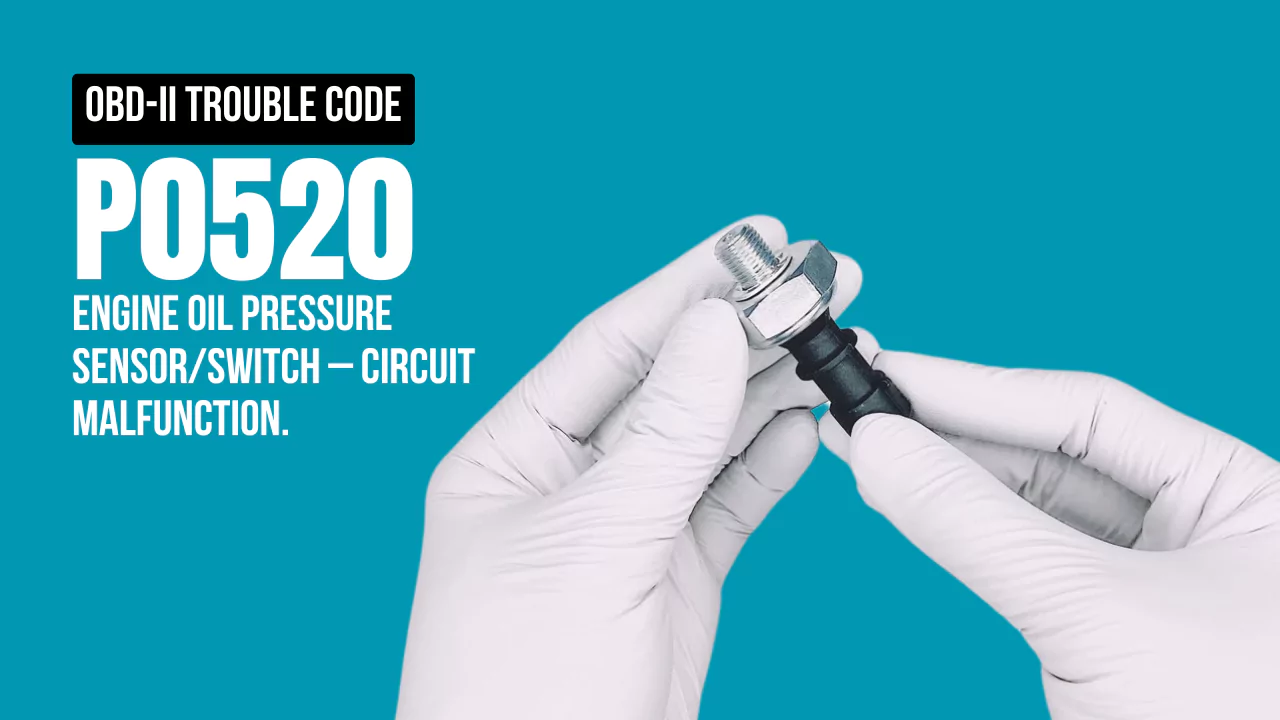The OBD trouble code P0520 relates to the vehicle’s engine oil pressure sensor or switch and its associated electrical circuit and its operation. It’s a threshold issue with the oil pressure sensor, and the Powertrain Control Module (PCM) picks it up.
When the PCM notices a signal from the sensor that is either too high or too low compared to the manufacturer’s parameters, it will trigger the P0520 code. If a red oil pressure light is associated with the code, then there could be a severe mechanical problem.
What Does Code P0520 Mean?
The P0520 code stands for “Engine Oil Pressure Sensor/Switch – Circuit Malfunction.”

If you’ve scanned for trouble codes with your code reader and find P0520, it’s likely because the Check Engine Light was already on. This code refers to an unspecified problem with the engine oil pressure sensor or switch circuit.
This sensor monitors the oil pressure your engine produces, ensuring that it flows properly throughout the engine to lubricate and cool it all internally.
Typically installed in the engine block or on the oil filter housing, the sensor is almost always a simple spring switch. When the engine is off, the switch or sensor is in the closed position, indicating no oil pressure.
When the engine runs and oil pressure is produced, the switch changes to the open position. In some cases, the sensor can even measure the internal oil pressure.
If the sensor doesn’t detect oil pressure when the key is on and the engine is running, it can trigger the P0520 code, and the Check Engine Light pops on.
This code is key to figuring out whether you have an oil pressure problem before it causes severe internal engine damage, or if it’s simply an issue with the engine oil pressure sensor’s circuit.
What are the Possible Causes of the P0520 Code?
Knowing the possible origin of the problem helps in troubleshooting any trouble code. It is important to know what’s causing the P0520 code before taking action. Make sure to take note of these probable causes:
- Bad oil pressure sensor
- Damaged or corroded wires to the oil pressure switch/sensor
- Loose connections to the oil pressure sensor
- Use of incorrect (inappropriate viscosity) oil
- Insufficient oil
- Insufficient oil pressure due to dirty engine oil
- Excessive resistance in the circuit
- Contaminated engine oil
- Mechanical failure of the chain tensioners
- Faulty parts, such as a bad relief valve or oil pump
- Damaged or old oil filter
- Oil leaks within the fuel lines
- Bad PCM/ECM
What are the Common Symptoms of Code P0520?
Be keen in observing any changes in your vehicle. There could be multiple symptoms for code P0520. Here are the common ones you need to watch for:
- Check engine light illumination
- Excessive noise from the engine
- The vehicle is hard to start or won’t start at all
- A clear reduction in engine performance
- The limp mode is activated
- Engine misfiring
- The oil pressure warning light is flashing
How to Diagnose a P0520 Code
With only a few tools, you can diagnose the cause of the P0520 trouble code so you can get to the proper repair. You might need:
- A code reader
- A digital multimeter
- An engine oil pressure tester
- Common wrenches, screwdrivers, and sockets
Step 1: Scan for codes. Using your code reader, confirm that it’s code P0520 that’s present. Mark down any other codes that may be present. You may want to clear the codes, then run the engine and see if the Check Engine Light reappears.
Step 2: Inspect the oil level and quality. If your engine oil is low or it’s laden with sludge, it’s milky, or has shimmering metal particles, it can indicate a mechanical condition rather than a sensor issue.
Step 3: Check the oil pressure sensor. Although you can’t visually inspect the switch inside, check what you can by eye. It’s possible the wiring connector is broken or there’s obvious corrosion or oil contamination on it. Test the switch’s continuity with the digital multimeter with the engine running, confirming that the switch is open.
Step 4: Inspect the wiring and harness. Verify that the wiring connector is free from corrosion and other contaminants at the switch. Trace the wiring harness back to where it joins the main harness, checking for breaks or other damage.
Step 5: Perform an oil pressure test. Using an oil pressure tester kit, measure the actual oil pressure your engine is producing. If it’s lower than the specification the manufacturer provides, there could be a more significant repair required such as an oil pump replacement or an engine rebuild.
Diagnostic Mistakes
- Not inspecting all the parts.
- Replacing the oil pressure sensor before properly inspecting all the parts.
- Changing the unnecessary parts.
How Serious Is the P0520 Code?
The P0520 and its related codes can be extremely serious. In addition, if your car’s oil pressure reaches too high or too low of levels, it can seize the crankshaft and connecting rod bearing.
This essentially renders your engine non-functional and can be a catastrophic problem for you. This is why it’s critical to have your vehicle taken to a certified service center as soon as you’re able to.
Can I Still Drive with a P0520 Code?
It is firmly not recommended to drive your vehicle for any period if presented with the P0520 or its related codes. This is because oil pressure is one of the most critical conditions to maintain in your car for its regular operation.
If your car falls out of the specified range for oil pressure for any period, then you are risking damage to the crankshaft system and the connecting rod bearings and other internal components.
This puts you at risk for catastrophic damage to your engine and can even lead to your engine ceasing to work altogether.